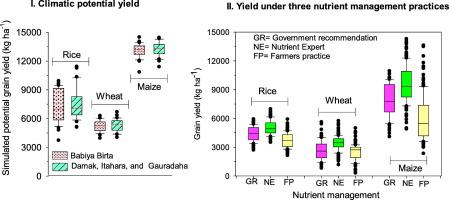Agricultural Systems ( IF 6.1 ) Pub Date : 2021-05-24 , DOI: 10.1016/j.agsy.2021.103181 Jagadish Timsina , Sudarshan Dutta , Krishna Prasad Devkota , Somsubhra Chakraborty , Ram Krishna Neupane , Sudarshan Bishta , Lal Prasad Amgain , Vinod K. Singh , Saiful Islam , Kaushik Majumdar

|
CONTEXT
Smallholder farmers of the Eastern Indo-Gangetic Plains (EIGP) of South Asia rely mainly on cereal-based cropping systems to meet the food and nutritional demand and support their livelihood. Yet the productivity of the major cereals - rice, wheat, and maize - in the region are far lower than their potential. Nutrient management plays a crucial role in improving cereal yields and economic return, and continued improvement in nutrient management practices and their on-farm implementation is required to develop locally relevant solutions that are site-specific, easy-to-develop and geared towards system resilience.
OBJECTIVES
The objective of the study was to conduct the comparative assessment of three nutrient management strategies for the three major cereals considering productivity, profitability and nutrient use efficiencies (NUE); estimate their potential yields and yield gaps; and explain the causes of yield variability across farmer-participatory on-farm trials in the EIGP of Nepal.
METHODS
We compared three nutrient management strategies (farmer's fertilizer practice- FP, government recommendation -GR, and Nutrient Expert®- NE-based recommendation), in 600 on-farm trials. We used the NE DSS tool, APSIM – a cropping system simulation model, and machine learning (ML) approaches (Linear Mixed Effect model -LME; and Random Forest model - RF) for the three cereals using data from those trials. The NE and APSIM were chosen due to simplicity in use and their wider evaluation and application in fertilizer recommendation yield prediction; RF was chosen due to its robustness in predictive ability and identifying and ranking factors determining yield or other variables of interest.
RESULTS
The NE-based fertilizer recommendations for maize, wheat and rice increased yield by about 3.5, 1.4, and 1.3 t ha−1 respectively, increased profits, and improved NUE over FP or GR. The risk analysis showed that at a given probability level, NE always resulted in higher yields of all cereals than GR or FP. APSIM identified 25th June as optimum transplanting date for rice and 10th December as optimum sowing date for maize and wheat and simulated long-term average potential yield of 7–7.5, 5–5.5 and 13–13.3 t ha−1 respectively for rice, wheat and maize. There were larger yield gaps between PY and FP (2.6–8.5 t ha−1) than PY and NE (2.0–3.7 t ha−1) across crops and villages. The LME model showed highly significant treatment and location effects for grain yield of all cereals. The point estimate of the difference for grain yield as estimated by Tukey's HSD test was highest for NE-FP and lowest for GR-FP for all crops. The RF model identified grain N uptake for rice and grain P and K uptakes for wheat and maize as most influential factors contributing to their grain yield under each nutrient management strategy.
CONCLUSIONS
The NE-based nutrient management had significant effects over FP and GR leading to positive changes on yield and economic performance under varied growing environments.
SIGNIFICANCE
These findings based on novel tools and approaches have important policy implications for increasing food security and profits from the major cereals by refining or improving the GR or FP and increasing their NUE in Nepal. Studies with larger sample size across varied agro-climatic zones in the EIGP and much of South Asia would help policy makers consider DSS tools and ML approaches suitable for upscaling and large-scale adoption by smallholder farmers.
中文翻译:

使用Nutrient Expert和机器学习工具改善谷物的营养管理:生产率,利润率和养分利用效率
语境
南亚东部印度恒河平原(EIGP)的小农主要依靠谷物种植系统来满足粮食和营养需求并维持生计。然而,该地区主要谷物(水稻,小麦和玉米)的生产力远低于其潜力。营养管理在提高谷物产量和经济回报方面起着至关重要的作用,需要不断改善养分管理方法及其在农场的实施,以开发针对当地的解决方案,这些解决方案应针对特定地点,易于开发并具有系统适应性。
目标
研究的目的是对三种主要谷物的三种养分管理策略进行比较评估,其中考虑了生产力,获利能力和养分利用效率(NUE);估计其潜在的产量和产量缺口;并解释了尼泊尔EIGP中农民参与的农场试验中产量差异的原因。
方法
在600个农场试验中,我们比较了三种养分管理策略(农民的施肥策略-FP,政府推荐-GR和基于NutrientExpert®-NE的推荐)。我们使用来自这些试验的数据对三种谷物使用了NE DSS工具,APSIM(一种作物系统模拟模型)和机器学习(ML)方法(线性混合效应模型-LME;以及随机森林模型-RF)。选择NE和APSIM的原因是使用简便,并且在肥料推荐产量预测中具有更广泛的评估和应用;选择RF是因为其在预测能力,确定收益或其他目标变量的因素和确定因素方面的稳健性。
结果
针对玉米,小麦和水稻的基于NE的肥料建议分别使产量分别提高了约3.5、1.4和1.3 t ha -1,增加了利润,并且与FP或GR相比提高了NUE。风险分析表明,在给定的概率水平下,NE总是比GR或FP导致所有谷物的单产更高。APSIM确定6月25日为水稻的最佳移植日期,12月10日为玉米和小麦的最佳播种日期,模拟的水稻,小麦的长期平均潜在单产分别为7–7.5、5–5.5和13–13.3 t ha -1和玉米。PY和FP(2.6–8.5 t ha -1)之间的产量差距大于PY和NE(2.0–3.7 t ha -1)),遍及农作物和村庄。LME模型对所有谷物的谷物产量均表现出高度显着的处理和定位效果。通过图基的HSD测试估计,在所有作物中,NE-FP最高的谷物产量差异的点估计值最高,而GR-FP最低。RF模型确定了在每种养分管理策略下,水稻吸收的氮素,小麦和玉米吸收的磷,钾素是影响其籽粒产量的最重要因素。
结论
基于NE的营养管理对FP和GR具有显着影响,从而在变化的生长环境下对产量和经济绩效产生积极影响。
意义
这些基于新颖工具和方法的发现,通过完善或改善遗传资源或粮食计划署以及增加其在尼泊尔的NUE,对提高粮食安全和从主要谷物中获利具有重要的政策意义。在EIGP和南亚大部分地区的不同农业气候区进行较大样本规模的研究,将有助于政策制定者考虑适合小农户扩大规模和大规模采用的DSS工具和ML方法。











































 京公网安备 11010802027423号
京公网安备 11010802027423号